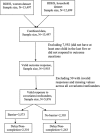Are perceived barriers to accessing health care associated with inadequate antenatal care visits among women of reproductive age in Rwanda?
- PMID: 32041559
- PMCID: PMC7011379
- DOI: 10.1186/s12884-020-2775-8
Are perceived barriers to accessing health care associated with inadequate antenatal care visits among women of reproductive age in Rwanda?
Abstract
Background: Maternal and child mortality remain a global health concern despite different interventions that have been implemented to address this issue. Adequate antenatal care (ANC) is crucial in reducing maternal and neonatal morbidity and mortality. However, in Rwanda, there is still suboptimal utilization of ANC services. This study aims to assess the relationship between perceived barriers to accessing health care and inadequate ANC visits among women of reproductive age in Rwanda.
Methods: This study is cross-sectional using secondary data from the 2014-15 Rwanda demographic and health survey (RDHS). The study included 5876 women aged 15-49 years, and the primary outcome of the investigation was inadequate ANC visits defined as delayed first ANC visit and non-completion of at least four recommended visits during the pregnancy period. The primary exposure was perceived barriers to accessing health care, operationalized using the following 4 variables: distance to the health facility, getting money for treatment, not wanting to go alone and getting permission to go for treatment. A survey-weighted multivariable logistic regression analysis and backward elimination method based on Akaike information criterion (AIC) was used to select the final model. We conducted a number of sensitivity analyses using stratified and weighting propensity score methods and investigated the relationship between the outcome and each barrier to care separately.
Results: Of 5, 876 women included in the analysis, 53% (3132) aged 20 to 34 years, and 44% (2640) were in the lowest wealth index. Overall, 64% (2375) of women who perceived to have barriers to health care had inadequate ANC visits. In multivariable analysis, women who perceived to have barriers to health care had higher odds of having inadequate ANC visits (OR: 1.14; 95% CI: 0.99, 1.31). However, the association was borderline statistically significant. The findings from sensitivity analyses were consistent with the main analysis results.
Conclusion: The study suggests a positive association between perceived barriers to health care access and inadequate ANC visits. The findings speak to a need for interventions that focus on improving access to health care in Rwanda to increase uptake of ANC services.
Keywords: Antenatal care; Barriers to care; Demographics and health survey; Maternal health; Rwanda.
Conflict of interest statement
MPN is supported by the University of British Columbia 4 Year Doctoral Fellowship. GT declares no competing interests
Figures
Similar articles
-
Assessing predictors of delayed antenatal care visits in Rwanda: a secondary analysis of Rwanda demographic and health survey 2010.BMC Pregnancy Childbirth. 2014 Aug 28;14:290. doi: 10.1186/1471-2393-14-290. BMC Pregnancy Childbirth. 2014. PMID: 25163525 Free PMC article.
-
Evolution and determinants of antenatal care services utilization among women of reproductive age in Rwanda: a scoping review.BMC Health Serv Res. 2024 Dec 21;24(1):1636. doi: 10.1186/s12913-024-12038-0. BMC Health Serv Res. 2024. PMID: 39709445 Free PMC article.
-
Association between adequacy of antenatal care and neonatal outcomes in Rwanda: a cross-sectional study design using the Rwanda demographic and health surveys.BMC Health Serv Res. 2023 Dec 8;23(1):1379. doi: 10.1186/s12913-023-10345-6. BMC Health Serv Res. 2023. PMID: 38066497 Free PMC article.
-
Prenatal care and uptake of HIV testing among pregnant women in Gambia: a cross-sectional study.BMC Public Health. 2020 Apr 15;20(1):485. doi: 10.1186/s12889-020-08618-4. BMC Public Health. 2020. PMID: 32293382 Free PMC article.
-
Factors influencing the uptake of antenatal care in Uganda: a mixed methods systematic review.BMC Pregnancy Childbirth. 2024 Nov 8;24(1):730. doi: 10.1186/s12884-024-06938-6. BMC Pregnancy Childbirth. 2024. PMID: 39516857 Free PMC article.
Cited by
-
Distance matters: barriers to antenatal care and safe childbirth in a migrant population on the Thailand-Myanmar border from 2007 to 2015, a pregnancy cohort study.BMC Pregnancy Childbirth. 2021 Dec 2;21(1):802. doi: 10.1186/s12884-021-04276-5. BMC Pregnancy Childbirth. 2021. PMID: 34856954 Free PMC article.
-
Barriers to accessing healthcare among women in Ghana: a multilevel modelling.BMC Public Health. 2020 Dec 17;20(1):1916. doi: 10.1186/s12889-020-10017-8. BMC Public Health. 2020. PMID: 33334326 Free PMC article.
-
Number of antenatal care utilization and associated factors among pregnant women in Ethiopia: zero-inflated Poisson regression of 2019 intermediate Ethiopian Demography Health Survey.Reprod Health. 2022 Feb 5;19(1):36. doi: 10.1186/s12978-022-01347-4. Reprod Health. 2022. PMID: 35123503 Free PMC article.
-
Evaluating continuum of maternal and newborn healthcare in Rwanda: evidence from the 2019-2020 Rwanda demographic health survey.BMC Pregnancy Childbirth. 2022 Oct 19;22(1):781. doi: 10.1186/s12884-022-05109-9. BMC Pregnancy Childbirth. 2022. PMID: 36261801 Free PMC article.
-
Individual and contextual factors associated with barriers to accessing healthcare among women in Papua New Guinea: insights from a nationwide demographic and health survey.Int Health. 2021 Dec 1;13(6):573-585. doi: 10.1093/inthealth/ihaa097. Int Health. 2021. PMID: 33278299 Free PMC article.
References
-
- Reproductive, Maternal, Newborn, Child and Adolescent Health. World Bank. [cited 2018 Nov 29]. Available from: http://www.worldbank.org/en/topic/reproductivematernalchildhealth.
-
- Ahmed I, Ali SM, Amenga-Etego S, Ariff S, Bahl R, Baqui AH, et al. Population-based rates, timing, and causes of maternal deaths, stillbirths, and neonatal deaths in South Asia and sub-Saharan Africa: a multi-country prospective cohort study. Lancet Glob Health. 2018;6(12):e1297–e1308. doi: 10.1016/S2214-109X(18)30385-1. - DOI - PMC - PubMed
-
- World Health Organization, editor. WHO recommendations on antenatal care for a positive pregnancy experience. Geneva: World Health Organization; 2016. p. 152. - PubMed
MeSH terms
Grants and funding
LinkOut - more resources
Full Text Sources
Medical


